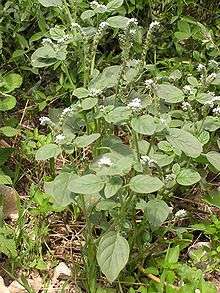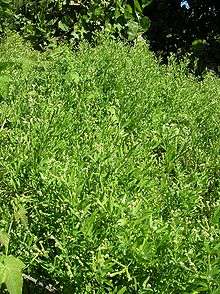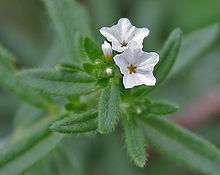Heliotropium
| Heliotropium | |
|---|---|
 | |
| Heliotropium arborescens | |
| Scientific classification | |
| Kingdom: | Plantae |
| Clade: | Angiosperms |
| Clade: | Eudicots |
| Clade: | Asterids |
| Order: | Boraginales |
| Family: | Boraginaceae |
| Subfamily: | Heliotropioideae |
| Genus: | Heliotropium L. |
| Type species | |
| Heliotropium europaeum L. [1] | |
| Species | |
|
250-300, see text | |
| Synonyms | |
|
Beruniella Zakirov & Nabiev | |
Heliotropium /ˌhiːliəˈtroʊpiəm,
Etymology
The name "heliotrope" derives from the old idea that the inflorescences of these plants turned their rows of flowers to the sun.[5] Ἥλιος (helios) is Greek for "sun", τρέπειν (trepein) means "to turn". The Middle English name "turnsole" has the same meaning.
Ecology and human use
_W_IMG_9949.jpg)
Several heliotropes are popular garden plants, most notably garden heliotrope (H. arborescens). Some species are weeds, and many are hepatotoxic if eaten in large quantities due to abundant pyrrolizidine alkaloids. There have been cases of canine death due to over-ingestion of this toxic plant.[6] Some danaine butterflies, such as male queen butterflies, visit these plants, being attracted to their pyrrolizidine alkaloids [7] Though it is not palatable and most animals will completely ignore it, there have been cases of horses, swine and cattle being poisoned due to contamination of hay.[8]
Caterpillars of the grass jewel (Freyeria trochylus), a gossamer-winged butterfly, feed on H. strigosum.
The sap of heliotrope flowers, namely of European heliotrope (H. europaeum), was used as a food coloring in Middle Ages and Early Modern French cuisine.
One of the most famous ragtime piano melodies is "Heliotrope Bouquet", composed in 1907 by Louis Chauvin (the first two strains) and Scott Joplin (the last two strains).
Garden heliotrope is grown in Southern Europe as an ingredient for perfume.[9]
The purplish facial rash of dermatomyositis is called "heliotrope rash" because it resembles E. arborescens.[10]
Taxonomy
Taxonomic revision supported through molecular phylogenetics led to the recognition of Euploca as genus separate from Heliotropium.[11][4] In contrast, the genus Tournefortia was included in Heliotropium in a 2016 revision.[4]
Within Heliotropium, there are four major clades:[4]
- Heliotropium sect. Heliothamnus I.M.Johnst.
- Old World Heliotropium clade
- Heliotropium sect. Cochranea (Miers) Post & Kuntze
- Tournefortia clade, comprising Tournefortia sect. Tournefortia and all remaining New World Heliotropium species
Selected species


_W_IMG_9746.jpg)


- Heliotropium amplexicaule Vahl – clasping heliotrope, summer heliotrope, blue heliotrope
- Heliotropium anderssonii
- Heliotropium angiospermum
- Heliotropium anomalum Hook. & Arn. – Polynesian heliotrope, Pacific heliotrope (Pacific Islands)
- Heliotropium anomalum var. argenteum – hinahina kū kahakai (Hawaii)
- Heliotropium arborescens – garden heliotrope, common heliotrope, cherry pie
- Heliotropium argenteum
- Heliotropium asperrimum R.Br.
- Heliotropium balfourii
- Heliotropium bracteatum R.Br.
- Heliotropium conocarpum F.Muell. ex Benth.
- Heliotropium crispatum F.Muell. ex Benth.
- Heliotropium diversifolium F.Muell. ex Benth.
- Heliotropium chenopodiaceum (A.DC.) Clos.
- Heliotropium claussenii DC.
- Heliotropium curassavicum L. – seaside heliotrope, salt heliotrope, monkey tail, quail plant, Chinese parsley; cola de mico (Spanish)
- Heliotropium dentatum
- Heliotropium derafontense
- Heliotropium ellipticum
- Heliotropium epacrideum F.Muell. ex Benth.
- Heliotropium europaeum L. – European heliotrope, European turnsole (Europe, Asia, and North Africa)
- Heliotropium fasciculatum R.Br.
- Heliotropium flintii F.Muell. ex A.S.Mitch.
- Heliotropium foertherianum Diane & Hilger – tree heliotrope, velvet soldierbush, octopus bush (South Asia, East Asia, Melanesia, western Polynesia, northern Australia)
- Heliotropium foliatum R.Br.
- Heliotropium glabellum R.Br.
- Heliotropium heteranthum (F.Muell.) Ewart & O.B.Davies
- Heliotropium indicum L. – Indian turnsole
- Heliotropium kuriense
- Heliotropium laceolatum Loefg.
- Heliotropium lineariifolium Phil.
- Heliotropium megalanthumn I.M.Johnst.
- Heliotropium nigricans
- Heliotropium paniculatum R.Br.
- Heliotropium pannifolium – St. Helena heliotrope (Saint Helena) (extinct, c. 1820)
- Heliotropium pauciflorum R.Br.
- Heliotropium paulayanum
- Heliotropium pleiopterum F.Muell.
- Heliotropium prostratum R.Br.
- Heliotropium ramosissimum
- Heliotropium riebeckii
- Heliotropium shoabense
- Heliotropium sinuatum (Miers) I.M.Johnst.
- Heliotropium socotranum
- Heliotropium stenophyllum
- Heliotropium strigosum Willd.
- Heliotropium tenellum
- Heliotropium ventricosum R.Br.
- Heliotropium wagneri
- Heliotropium aff. wagneri (Samhah, Yemen)
Formerly included here
- Chrozophora tinctoria (as H. tricoccum)
- Tournefortia gnaphalodes (L.) R.Br. ex Roem. & Schult. (as H. gnaphalodes L.)[12]
See also
References
- ↑ "Heliotropium L". TROPICOS. Missouri Botanical Garden. Retrieved 2010-01-12.
- ↑ "Genus: Heliotropium L". Germplasm Resources Information Network. United States Department of Agriculture. 2006-04-02. Archived from the original on 2009-08-27. Retrieved 2010-01-12.
- ↑ Sunset Western Garden Book, 1995:606–607
- 1 2 3 4 Luebert, F.; Cecchi, L.; Frohlich, M.W.; et al. (2016). "Familial classification of the Boraginales" (PDF). Taxon. 65 (3): 502–522. doi:10.12705/653.5. ISSN 0040-0262. Retrieved 16 June 2018.
- ↑ Chittenden, Fred J. Ed., Royal Horticultural Society Dictionary of Gardening, Oxford 1951
- ↑ http://www.limerickvet.com/news-info/pet-news/in-remembrance-of-goldie/
- ↑ Male sex pheromone of a giant danaine butterfly, Idea leuconoe
- ↑ Witherill, Richard. "Heliotrope". PAWS Dog Daycare. Retrieved 27 January 2014.
- ↑ Floridata: Heliotropium arborsecens
- ↑ http://www.dermnetnz.org/immune/dermatomyositis.html
- ↑ Hilger, H.H.; Diane, N. (2003). "A systematic analysis of Heliotropiaceae (Boraginales) based on trnL and ITS1 sequence data". Botanische Jahrbücher. 125 (1): 19–51. doi:10.1127/0006-8152/2003/0125-0019. ISSN 0006-8152.
- ↑ "GRIN Species Records of Heliotropium". Germplasm Resources Information Network. United States Department of Agriculture. Retrieved 2010-09-17.
- Everitt, J.H.; Lonard, R.L.; Little, C.R. (2007). Weeds in South Texas and Northern Mexico. Lubbock: Texas Tech University Press. ISBN 0-89672-614-2.
External links
| Wikimedia Commons has media related to Heliotropium. |
| Wikispecies has information related to Heliotropium |
- A Heliotrope at Gardener's Path
- Picture of Heliotropium chenopodiaceum at Chileflora